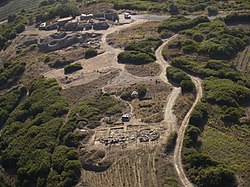
Back Castro do Zambujal Czech Zambujal German Zambujalgo kastroa Basque Castro de Zambujal French Zambujal Italian Zambujal Polish Castro do Zambujal Portuguese Замбужаль Russian
 The excavations on the Zambujal promontory in 2007, showing in front the 4th fortification line | |
 | |
| Location | Lisbon, Portugal |
|---|---|
| Coordinates | 39°4′27.78″N 9°17′8.20″W / 39.0743833°N 9.2856111°W |
| Type | Settlement |
| History | |
| Founded | c. 3000 BC |
| Abandoned | c. 1700 BC |
| Site notes | |
| Discovered | 1932 by Leonel Trindade |
The Castro of Zambujal (Portuguese: Castro do Zambujal) is a Chalcolithic age archeological site in the municipality of Torres Vedras in the western litoral area of the Centro Region, Portugal. The Zambujal Castro is one of the most important Copper Age settlements in the peninsula of Lisbon, and whose culture lasted until the beginning of the agrarian periods of Iberian history. Apart from being the most northerly discovered Copper Age site in Portugal, it went through two main building phases: an import-oriented phase and the second associated with the Beaker culture.
Most of the artefacts discovered at the site are stored and displayed in the Leonel Trindade Municipal Museum, Torres Vedras.[1]